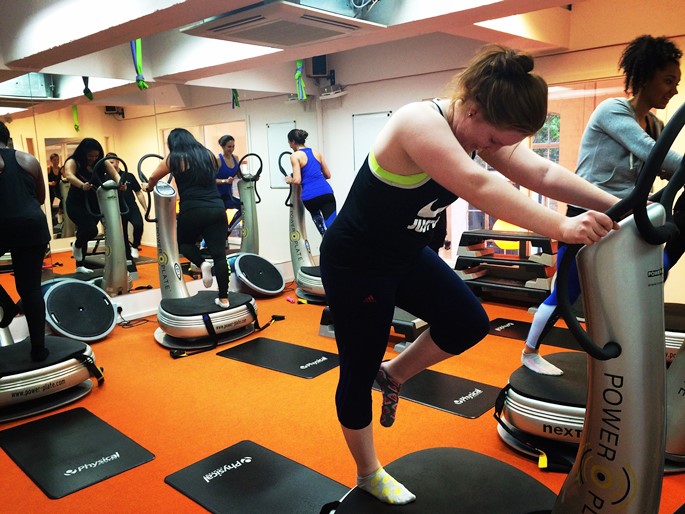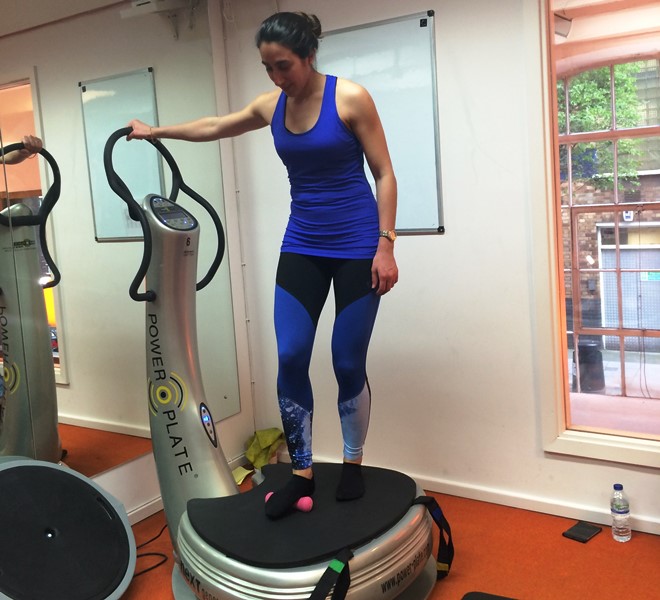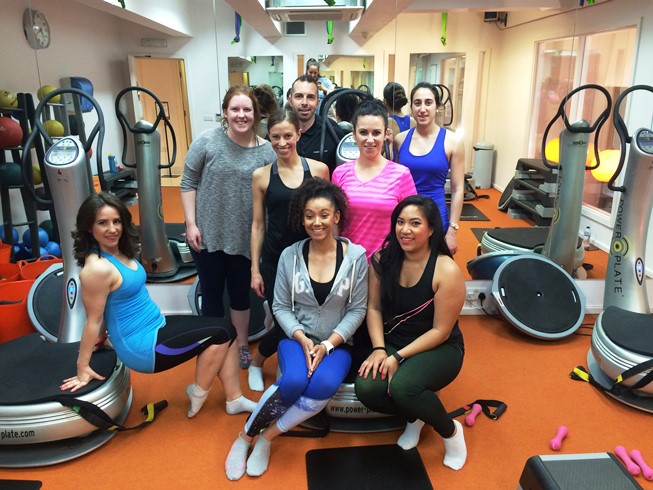When we first heard about whole body vibration training, it was ‘sold’ as a way of getting a full hour’s worth of exercise in the space of a few minutes. This is because the vibrations of the platform activate your muscle receptors, making your body work harder as you exercise. We were invited by Power Plate, the biggest (and best known) player in the vibration training industry, to learn about how vibration technology can be used for a totally different purpose: activation and recovery. This sounded very intriguing, indeed! For a change, we were treated to a class focused on looking after rather than pushing our bodies. We left the class feeling, not just stretched out and more supple, but also much better informed.
At Good Vibes in Covent Garden, apart from a lovely yoga studio, there is also a fully equipped whole body vibration training and conditioning studio. This is where we met Steve Powell, Director of Education and Training at Power Plate and Performance Health Systems. It was immediately obvious that Steve has a wealth of knowledge both about the Power Plate vibration technology itself, but also about the science behind vibration training (of which there is a lot – fitness science geeks see here). He kicked off the workshop by setting out the context. With a record 250,000+ UK entrants to the ballot for the 2017 London Marathon, it’s obvious that distance running is a sport ever increasing in popularity – even I’m thinking of upping my distance to 10k *shock*horror*! Our workshop actually took place less than two weeks after the London Marathon and just a few days before Run Hackney, so at the time there were many runners in our city who were either recovering after a major race or getting ready to put their racing bibs on.
As all runners know, a thorough warm-up routine and stretching during training are fundamental to make sure injuries are kept at bay, while proper recovery after an event is essential. Now I don’t know a huge amount about running-specific warm-ups, but I do know that in general with any exercise, the warm-up is about activating, mobilising and getting blood flowing to the muscles and joints you will be using during your workout. So for running, we’re looking at things like lunges, high-knees, butt-kicks, etc. These are of course highly necessary exercises to get your knees, and hips moving pre-run. But there are various ligaments and less obvious muscle groups that are crucial for good running form, but are often overlooked. Until they get injured.
Take the plantar fascia, the ligament that connects your heel to your big toe, and the bane of many a runner. Or the big toe joint itself for that matter. Mobility in this joint can determine how powerful and how stable your stride is and even has a role in whether or not your over-pronate. The Power Plate’s vibrations, 25-50 times per second in three planes (up/down, forwards/backwards, and side-to-side), can come in really handy for activating these hard-to-reach joints and ligaments. Steve showed us how to operate the Power Plate and how to correctly move on the platform to make sure the vibrations go where you want them to and not to your skull – teeth chattering is not fun.
The first thing we did was to use a tiny pink dumbbell as a foot massager to warm up our plantar fascia. I used to think tiny pink dumbbells were totally useless – I was wrong! Next up was big toe, plus bonus hip flexor mobility, by holding a lunge with the ball of the back foot on the Power Plate. Reaching with the body and bending through the hips forward, backward and side to side, the hips and big toe joint move to compensate and so, thanks to the Power Plate vibrations, your joints (and glutes in this case) get properly activated and prepared for the full range of movements they will be expected to perform during your running strides.
We then talked about ankle activation and mobility. This was really useful for me, because I was still feeling a niggle from my obstacle course race a couple of weeks previously. The same logic applies here, with the movements on the Power Plate intended to mimic the various ways in which your joints move while running. Steve directed us to a one-legged dynamic knee drive movement that takes your ankle on an activation journey in all forward-facing directions. To throw in a bit of core and stability in the mix, Steve had us balancing on one leg and pointing to the four corners of the platform. Not so easy on a vibrating surface! Steve explained that this sort of stability training is often neglected after mobilisation work, which is a shame because it ‘solidifies’ the benefits of all that stretching.
Moving on more towards the recovery aspects of vibration training, Steve took us through an iliotibial band massage. Many runners suffer from tight ITB and it’s notoriously difficult and painful to deal with. By performing essentially a pigeon pose on the Power Plate, you can give your ITB a deep massage, while also stretching your piriformis, a small but important muscle deep in your buttocks – you’ll know it when you feel it!
To wrap it all up, we switched the Power Plate to full whack, lay on our backs with our legs on the platform and had a lovely calf massage that gave everyone the giggles!
This workshop was a totally new experience for me. I have limited experience of using vibration training platforms plus I only ever thought their purpose was to max out on your workout. As it turns out, they are a very effective – and scientifically proven – activation and recovery tool. Although our class was focused on running, I am sure that the same concept and logic applies for all kinds of sports and it would undoubtedly be very useful tool for rehabilitation after injury. I would recommend that you first invest in some time with a qualified trainer to be shown the most appropriate moves and stretches for you. Then just find yourself a Power Plate in a gym or studio (or, if you’re serious about your activation and recovery, you could even buy your own Personal Power Plate) and reap full range of benefits of whole body vibration training. You will most likely find me lying with my calves on the Power Plate smiling to myself.
More Information
Who’s it for: Runners of all abilities looking for injury-proofing and recovery.
How much: Varies by gym/location. Or you can buy your own Personal Power Plate for £1,194.
Where is it: Find out your nearest Power Plate here. We were hosted by Good Vibes Covent Garden, 14 – 16 Betterton Street, London, WC2H 9BU.
More information: www.powerplate.com



Leave a Reply